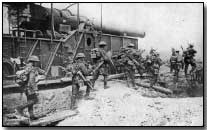Encyclopedia - Wiring Parties
 By no means a task for the
faint of heart, wiring duties were correctly regarded as being fraught with
danger.
By no means a task for the
faint of heart, wiring duties were correctly regarded as being fraught with
danger.
When assigned as a member of a wiring party - usually operating under the direction of more experienced NCOs - men would creep into No Man's Land under cover of darkness, a necessary precaution given the essentially unprotected nature of their activities.
Once there the wiring party would, as occasion demanded, insert new wiring posts (approximately 6 feet in height) ahead of the front trench, either by hammering the post with a muffled mallet, or else by winding the post in the manner of a screw (the earlier method being more common during the early stages of trench warfare).
Once the posts were in place reels of barbed wire - concertina wire - would be affixed to the post, unwound and attached to a second post (and often doubled back again to provide an additional layer of protection).
The task was one which obviously needed to be undertaken in strict secrecy and silence. Men assigned to wiring duties lived in constant fear of enemy flares, sent up to illuminate an area of the battlefield as if by daylight. Men caught in No Man's Land by such flares would either freeze until the light of the flare died, or else (more often) throw themselves instantly to the ground. It was not uncommon for enemy machine gun fire to accompany the sending up of flares as a precautionary measure.
Barbed wire, which could and often was laid to a formidable depth, proved difficult to destroy, although high explosive artillery was often launched so as to clear the enemy lines of wire; all too often however the wire remained uncut, as was disastrously the case for advancing British forces on the first day of the Battle of the Somme in 1916.
Wire would generally be laid at sufficient distance from the front line trench to prevent the possibility of enemy infantry lobbing grenades into the trench and fleeing. Furthermore wire would commonly be laid in such a configuration as to draw advancing enemy troops into ideal range for enfilading machine gun fire.
Where the distance between the enemy front lines was narrow - often the case on the trenches of the Western Front - it was not unusual for wiring parties of one side to encounter men from the opposing line engaged in the same task.
In such circumstances hand-to-hand fighting would often ensure (the use of pistols often instantly drawing deadly machine gun fire from both sides), or else one side would instantly flee back to their line in order to open up fire on the opposing wiring party.
Photograph courtesy of Photos of the Great War website
A "listening post" was an advanced post, usually in no-man's land, where soldiers tried to find out information about the enemy.
- Did you know?
